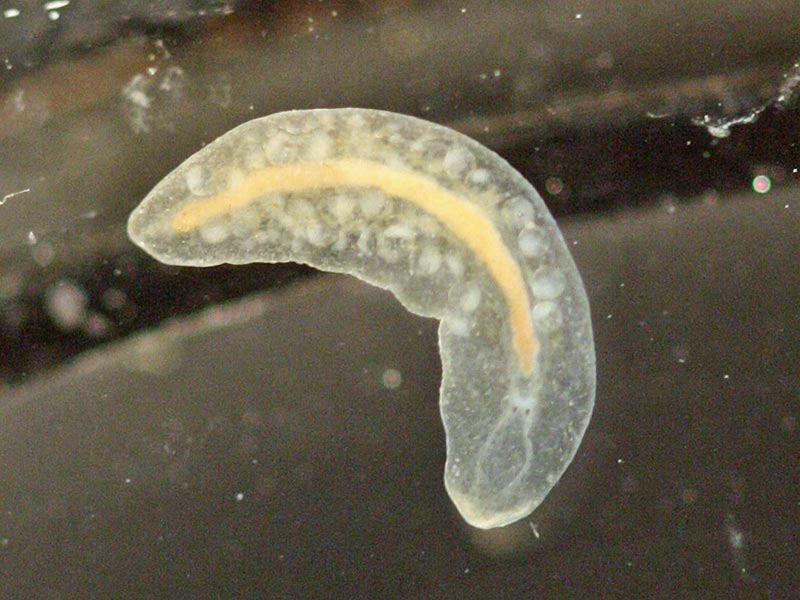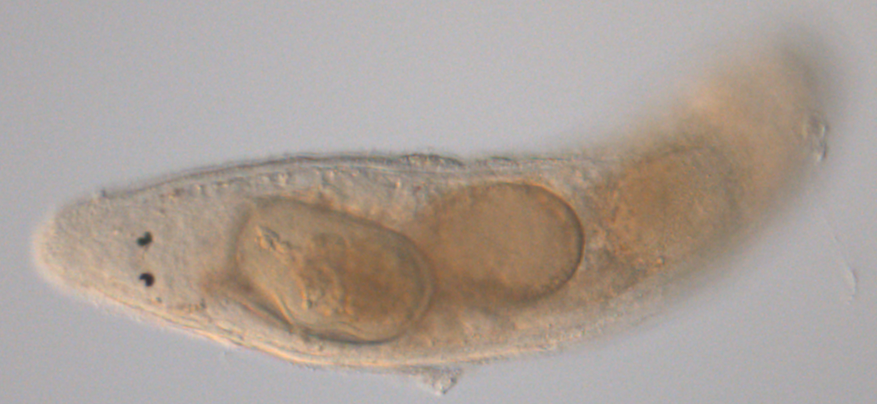Disc worms (Rhabdocoela)
Unfortunately, there is no really fixed definition for the animals that are often called "disc worms" in aquaristics. Theoretically, any worm that crawls over an aquarium pane would be addressed here ... but usually one means a certain kind of worm. In almost every aquarium these small harmless worms live, in fish aquariums rather unrecognized in the filter and in the bottom, in shrimp aquariums they come out of their hiding places.
They are often mistaken for planarians, and the reaction in Facebook groups and forums is often the same - pure scaremongering ... don't let this scare you, often the worms you see are not really harmful planarians!
What is a disc worm?
The name "disc worm" is generally used in aquaristics to describe whitish or reddish worms, which remain rather small with approx. 2-5 mm. They belong to the Rhabdocoela. These worms are a subgroup of the Turbellaria, i.e. the whirl worms or flat worms, they also have a very flat body shape accordingly. This makes them distantly related to the "real" freshwater planarians, which have a very bad reputation in aquaristics - but here we can give the all-clear right away, they are not dangerous for shrimps and crayfish as well as for fish (even for fish spawn), in contrast to planarians!
Disc worms are basically predatory as whirl worms, but they do not go to larger animals like shrimps or large snails and certainly not to crayfish. As a rule, they eat microorganisms, mainly other worms and protozoa. Some species will also eat freshly hatched snails. If there is a lot of food in the aquarium, disc worms multiply extremely.
Recognizing disc worms
Unlike leeches, disc worms have no recognizable segments, and their bodies have a flat, flattened cross-section. Under the microscope, a tiny pair of eyes can be seen in some species. In the light-colored disc worms, which usually belong to the genus Macrostomum, you can see the white-colored organs inside; in the reddish disc worms from the genus Bothromesostoma, you tend not to see them because of the dark coloration.

Locomotion
Disc worms crawl on a layer of mucus, moving fluidly (somewhat like a snail) rather than jerkily. When disturbed, they may contract spherically. Disc worms cannot swim.
Difference to planarians
Discworms are quite similar to planarians, they belong to the same class of animals - whirlworms, flatworms or turbellarians. However, since they are usually not dangerous for the aquarium stock, one should look very carefully and not immediately strike with Panacur, Flubenol, No Planaria and Co. - these means help against the Rhabdocoelen only in a dosage, which kills also everything else in the aquarium or at least seriously damages.
What do disc worms not have? Disc worms do not have clearly visible eyespots - they can only be seen under a microscope. Disc worms also don't have a clearly visible set off head - some species do taper to a point at the front, but they are definitely not arrow shaped. Furthermore, disc worms do not have a visibly branched intestine, and their pharynx is located at the front end, not in the middle of the abdomen like the "real" planarians.
Why do I have disc worms in the aquarium at all?
Often you buy Rhabdocoela with plants or with animals, they like to sit for example in the popular moss balls. Many species of disc worms can form cysts when conditions deteriorate. In nature, they often live in temporary waters that dry up, ensuring their survival. These cysts are very light and can be carried away by the wind - so it is quite possible for disc worms to appear even in aquariums that were initially completely sterile and set up with in vitro plants.
Reproduction of disc worms
Unlike "real" planaria, disc worms do not reproduce by division. They do not cut off body parts, but reproduce only sexually. The worms are hermaphrodites and can fertilize each other. The eggs then mature in the worm, the young hatch inside the parent's body and then crawl outside. It takes only two weeks for the disc worm offspring to become sexually mature again in turn, and at high temperatures it does not even take that long. Mass reproduction in the aquarium when there is an abundance of food is therefore possible within a very short time!
If there is a lot of food available, the disc worms reproduce extremely well. With little food the population decreases noticeably. Especially in the initial phase you will discover some disc worms in the aquarium - as long as the system is not yet stable, they will find plenty of food. Later, in moderately fed aquariums, the population decreases again. Especially the whitish worms tend to mass reproduction when fed a lot - the reddish ones (Bothromesostoma) are seen much less often and they apparently do not reproduce in the aquarium as much as other representatives of the Rhabdocoela.

Disc worms in the aquarium - is there a need for action?
Discworms belong to the normal accompanying fauna in the aquarium. They do not cause any harm to the aquarium stock - except possibly to young snails - and therefore do not necessarily need to be controlled. On the contrary, rhabdocoelas are a very good food for fish - one more point to distinguish them from the "real" planarians. These are eaten only in exceptional cases, because they produce a bitter slime.
Reduce disc worms
However, in the euphoria at the beginning you fed too much and now the discs are full of small white worms ... what to do? We have already noted that the common remedies against planaria do not work against disc worms.
Disc worms have many predators - most fish like to eat them. However, please do not put a fish in your aquarium specifically for this purpose. The worms are eaten quickly, the fish will still be there afterwards and in case of doubt will go to other small creatures like baby shrimps.
Basically, it is a good idea to feed adapted in the aquarium and not to introduce too much food into the system - excess nutrients can cause many problems in the aquarium from a population explosion in the accompanying fauna and snails to algae plagues. If you reduce the amount of food, the number of worms will soon decrease as well. Basically, you should only feed as much as can be absorbed by the fish and invertebrates in the aquarium within a few minutes - not hours. A reduction in food will certainly have the most lasting effect here, even if it takes a while to find fewer worms - the population needs some time to adapt to the new conditions.
